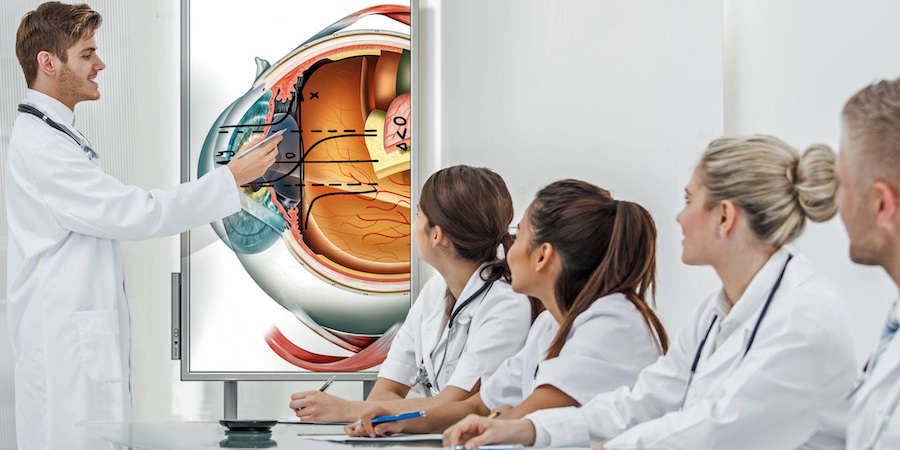Digital signage was originally touted in healthcare settings as a way to reduce perceived wait times in seating areas, but as more hospitals and clinics have adopted the technology, displays have become critical to their day-to-day operations.
Digital displays and related technologies are now being used to guide, inform and educate patients and their loved ones, even calming them while they wait. Clinicians, nurses and other staff are using them to collaborate with care teams and teach patients and their loved ones about their condition.
Here’s a look at some of the ways digital signage is being used in healthcare environments to enhance the patient experience and create a more efficient working environment for clinicians.
Streamline check-in
Checking in and taking a number may seem tedious, but the approach is effective for queue management in busy clinics, labs and urgent care centers. With a touchscreen, patients can inform the lobby’s queue management system that they’ve arrived and add their name to a sorted patient list. This information is then relayed to digital signage in the waiting area so people know where they are in line. Someone who was assigned waiting number 15, for example, can easily assess that there are 14 people ahead of them. That may not be great news, but the patient knows their approximate wait time and they can relax or even leave to grab a snack without missing their turn.
Reimagine healthcare facility design — brilliantly
Discover how digital displays can empower caregivers, engage patients, and elevate health brands. Download Now
These waiting room displays are particularly “sticky,” meaning people will look at them over and over. Savvy clinicians are interspersing the wait numbers with important messaging, such as encouraging flu shots or educating patients about preventative measures for common diseases.
Share key patient information
In treatment areas, patient door signage and central care station displays can share each patient’s status with their care team. Similar to digital meeting room signs, the displays are tied into data from patient management systems to indicate whether the room is occupied, the patient’s name or initials and key care information — from warnings and restrictions to whether the patient has received breakfast. This increases work efficiency for the hospital staff and keeps everyone on the same page about the patient’s status and needs, all while staying HIPAA compliant.
At the central station, indecipherable felt marker scribbles on patient assignment whiteboards are supplanted by real-time assignment and status displays, again tied into management systems.
Analyze and treat
Large commercial digital signage and curved, extra-wide desktop monitors now offer the color depth and high-resolution 4K detail needed to be useful to caregivers, notably specialists, for reviewing medical imaging. Plus, their ergonomic design provides health benefits for users over standard rectangular monitors. High dynamic range (HDR) technology in particular offers health practitioners vivid imaging, both for active patient care and in regular review meetings.
When the patient’s care team needs to review charts or medical images, the Flip 2 digital flipchart takes their collaboration a step further. Team members can draw diagrams and annotate directly on images, all of which can be saved and be shared with the patient or sent to their inbox.
Navigate the complex
At first glance, medical centers can be confusing and even daunting places for patients, who may already be worried about an ailment or injury. First, they need to find the right physician or clinic, and that can mean looking through dozens of names, rooms and building numbers.
Larger facilities are using large touchscreen displays as interactive directories and maps, fixed at major entryways and decision points. Compared to staffed information desks, these screens guide visitors more effectively and efficiently. Interactive maps can show a visitor where they are now and provide easy-to-follow directions to their destination. Digital directories can function in multiple languages to better serve the surrounding community. All of these features free up medical staff to focus on more complicated tasks.
Educate patients
For more than 20 years, specialist media companies focused on medical care have been working with clinic operations teams to install and operate patient education systems in waiting rooms. The cost of these initiatives is recovered through targeted ads that blend with the educational content.
Companies such as Chicago’s Outcome Health focus on condition-specific clinics, using digital signage in waiting rooms to relay custom content directed at specific audiences, such as people with diabetes. This targeted content allows patients to already feel somewhat informed before they meet with a specialist, especially if it’s their first appointment.
Recognize donors
In many larger medical facilities, donor recognition walls are a fundamental show of gratitude for the charitable contributions of corporations, families and individuals. Compared to engraved plaques, LED video walls and interactive digital signage enable medical centers to do much more — like highlighting donors in vibrant images and videos, while also providing engaging information about the center’s history, accomplishments and future plans.
Direct view LED screens, particularly the super-realistic microLED technology in Samsung’s The Wall, make it possible to fill entire walls of your lobby with engaging, informative visuals.
Comfort and celebrate
Some medical facilities in Europe have turned to LCD screens and narrow-bezel video walls to help patients relax. One Danish research team found that showcasing artwork, photography and music on digital signage is effective at calming anxious patients in waiting areas.
In Boston, the Spaulding Rehabilitation Hospital implemented LCD screens and video walls to celebrate past patients’ successful recoveries, reports Digital Signage Today.
Medical centers benefit greatly from digital signage. Sharing relevant information on easily updated screens can direct, educate and calm patients, while also streamlining operations for their care teams.
For more display options built for medical settings, check out Samsung’s full lineup of innovative healthcare TVs. And to make your healthcare displays as effective as possible, learn how to configure and tailor your real-time messaging using an integrated CMS with this free comprehensive guide.









